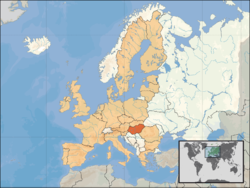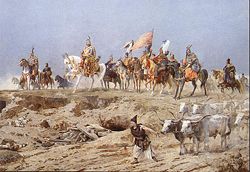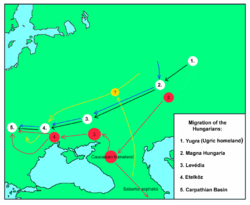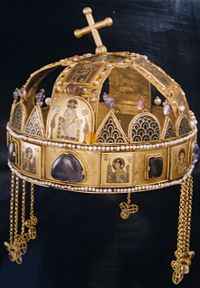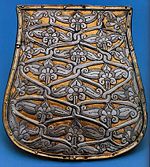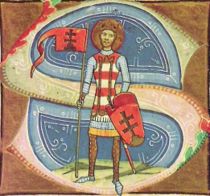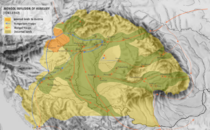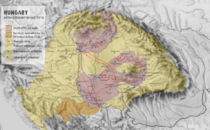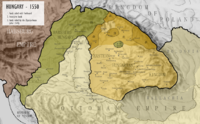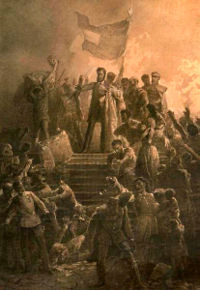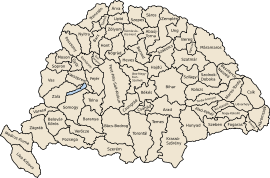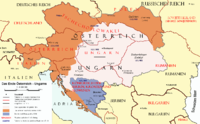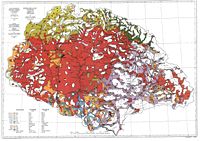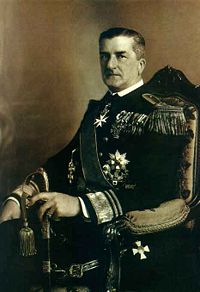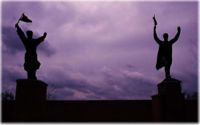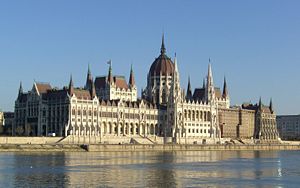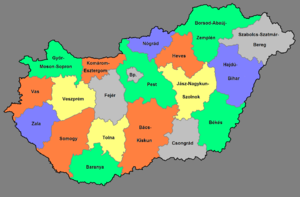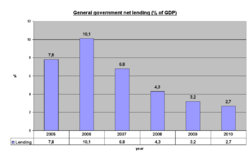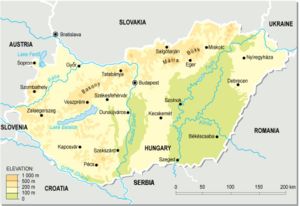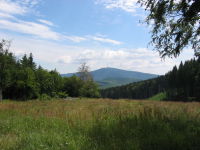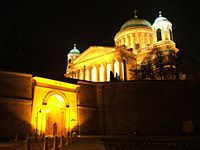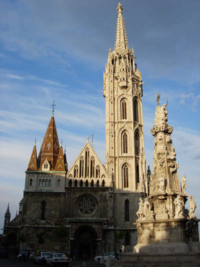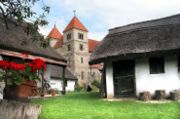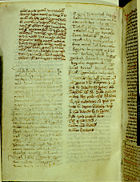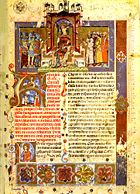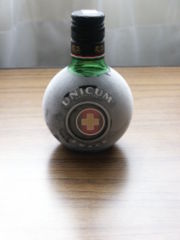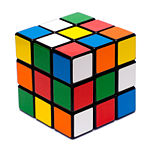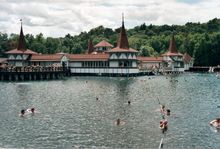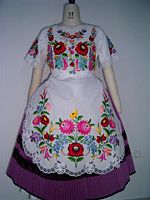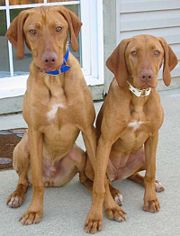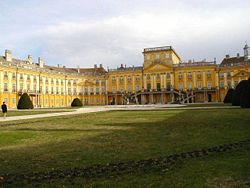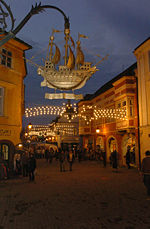Hungary
2008/9 Schools Wikipedia Selection. Related subjects: Europe; European Countries
| Magyar Köztársaság Republic of Hungary
|
||||||
|---|---|---|---|---|---|---|
|
||||||
| Motto: none Historically Regnum Mariae Patronae Hungariae (Latin) |
||||||
| Anthem: Himnusz ("Isten, áldd meg a magyart") "Hymn" ("God, bless the Hungarians") |
||||||
|
Location of Hungary (orange)
– on the European continent (camel & white) |
||||||
| Capital (and largest city) |
Budapest |
|||||
| Official languages | Hungarian (Magyar) | |||||
| Demonym | Hungarian | |||||
| Government | Parliamentary republic | |||||
| - | President | László Sólyom | ||||
| - | Prime minister | Ferenc Gyurcsány | ||||
| Foundation | ||||||
| - | Foundation of Hungary | 896 | ||||
| - | Recognized as Kingdom | December 1000 | ||||
| EU accession | May 1, 2004 | |||||
| Area | ||||||
| - | Total | 93,030 km² ( 109th) 35,919 sq mi |
||||
| - | Water (%) | 0.74% | ||||
| Population | ||||||
| - | 2008 February estimate | 10,041,000 ( 79th) | ||||
| - | 2001 census | 10,198,315 | ||||
| - | Density | 109/km² ( 94th) 282/sq mi |
||||
| GDP ( PPP) | 2008 estimate | |||||
| - | Total | $198.7 billion ( 48th) | ||||
| - | Per capita | $20.000 ( 39th) | ||||
| Gini (2008) | 24.96 (low) ( 3rd) | |||||
| HDI (2007) | ▲ 0.874 (high) ( 36th) | |||||
| Currency | Forint ( HUF) |
|||||
| Time zone | CET ( UTC+1) | |||||
| - | Summer ( DST) | CEST ( UTC+2) | ||||
| Internet TLD | .hu1 | |||||
| Calling code | +36 | |||||
| 1 | Also .eu as part of the European Union. | |||||
Hungary ( Hungarian: Magyarország; IPA: [mɒɟɒrorsaːg]; listen ), officially in English the Republic of Hungary (Magyar Köztársaság listen , literally Magyar (Hungarian) Republic), is a landlocked country in the Carpathian Basin of Central Europe, bordered by Austria, Slovakia, Ukraine, Romania, Serbia, Croatia, and Slovenia. Its capital is Budapest. Hungary is a member of OECD, NATO, EU and a Schengen state. The official language is Hungarian (also known as Magyar), which forms part of the Finno-Ugric family. It is one of the four official languages of the European Union that is not of Indo-European origin.
Following a Celtic (after c. 450 BC) and a Roman (9 BC - c. 4th century) period, the foundation of Hungary was laid in the late Ninth Century by the Magyar chieftain Árpád, whose great grandson István ascended to the throne with a crown sent from Rome in 1000. The Kingdom of Hungary existed with minor interruptions for almost 950 years, and at various points was regarded as one of the cultural centers of the Western world. It was succeeded by a Communist era (1947-1989) during which Hungary gained widespread international attention regarding the Revolution of 1956 and the seminal move of opening its border with Austria in 1989, thus accelerating the collapse of the Eastern Bloc. The present form of government is parliamentary republic (since 1989). Hungary's current goal is to become a developed country by IMF standards, having become already developed by most traditional measures, including GDP and HDI (world ranking 36th and rising). The country's first ever term of EU presidency is due in 2011.
Hungary was one of the 15 most popular tourist destinations in the world in the past decade, with a capital regarded as one of the most beautiful in the world. Despite its relatively small size, the country is home to numerous World Heritage Sites, UNESCO Biosphere reserves, the second largest thermal lake in the world ( Lake Hévíz), the largest lake in Central Europe ( Lake Balaton), and the largest natural grassland in Europe ( Hortobágy).
History
The land before the Magyars
In the time of the Roman Empire, the region west of the Danube river was known as Pannonia. After the Western Roman Empire collapsed under the stress of the migration of Germanic tribes and Carpian pressure, the Migration Period continued bringing many invaders to Europe. Among the first to arrive were the Huns, who built up a powerful empire under Attila. Attila the Hun was erroneously regarded as an ancestral ruler of the Hungarians. It is believed that the origin of the name "Hungary" does not come from the Central Asian nomadic invaders called the Huns, but rather originated from 7th century, when Magyar tribes were part of a Bulgar alliance called On-Ogour, which in Old Turkish meant "(the) Ten Arrows" . After Hunnish rule faded, the Germanic Ostrogoths then the Lombards came to Pannonia, and the Gepids had a presence in the eastern part of the Carpathian Basin for about 100 years. In the 560s the Avars founded the Avar Khaganate , a state which maintained supremacy in the region for more than two centuries and had the military power to launch attacks against all its neighbours. The Avar Khagnate was weakened by constant wars and outside pressure. The Franks under Charlemagne managed to defeat the Avars ending their 250 year rule. Neither the Franks nor others were able to create a lasting state in the region until the freshly unified Hungarians led by Árpád settled in the Carpathian Basin starting in 896. .
Medieval Hungary (896 – 1526)
Hungary is one of the oldest countries in Europe. It was founded in 896, before France and Germany became separate entities, and before the unification of Anglo-Saxon kingdoms. Medieval Hungary controlled more territory than medieval France, and the population of medieval Hungary was the third largest of any country in Europe. Árpád was the Magyar leader whom sources name as the single leader who unified the Magyar tribes via the Covenant of Blood(Vérszerződés) forged one nation, thereafter known as the Hungarian nation and led the new nation to the territory of the Carpathian Basin in the 9th century. After an early Hungarian state was formed in this territory military power of the nation allowed the Hungarians to conduct a lot of successful fierce campaigns and raids as far as present-day Spain.A later defeat at the Battle of Lechfeld in 955 signaled an end to raids on foreign territories, and links between the tribes weakened. The ruling prince (fejedelem) Géza of the House of Árpád, who was the ruler of only some of the united territory, but the nominal overlord of all seven Magyar tribes, intended to integrate Hungary into Christian (Western) Europe, rebuilding the state according to the Western political and social model. He established a dynasty by naming his son Vajk (later called Stephen) as his successor. This was contrary to the then dominant tradition of the succession of the eldest surviving member of the ruling family.
Hungary was established as a Christian kingdom under Stephen I of Hungary, who was crowned in December 1000 AD in the capital, Esztergom. He was the son of Géza and thus a descendant of Árpád. By 1006, Stephen had solidified his power, eliminating all rivals who either wanted to follow the old pagan traditions or wanted an alliance with the orthodox Christian Byzantine Empire. Then he started sweeping reforms to convert Hungary into a feudal state, complete with forced Christianisation. What emerged was a strong kingdom that withstood attacks from German kings and Emperors, and nomadic tribes following the Hungarians from the East, integrating some of the latter into the population (along with Germans invited to Transylvania and present-day Slovakia, especially after 1242), and subjugating Croatia in 1102. King Andrew II. led crusade to Holy Land in 1217.=> Fifth Crusade. The Golden Bull, (in 1222), was the first constitution in continental Europe. In 1241-1242, this kingdom received a major blow in the form of the Mongol invasion of Europe: after the defeat of the Hungarian army in the Battle of Muhi, King Béla IV fled, and a large part (though not as great as suspected by historians earlier) of the population died (leading later to the invitation of settlers from neighbours in the West and South) in the ensuing destruction (Tatárjárás). Only strongly fortified cities and abbeys could withstand the assault. As a consequence, after the Mongols retreated, King Béla ordered the construction of stone castles, meant to be defence against a possible second Mongol invasion. Mongols returned to Hungary in 1286, but the new built stone-castle systems and new tactics (with large ratio of heavy calvary) stopped them. The invading Mongol force was defeated near Pest by the royal army of king Ladislaus IV. These castles proved to be very important later in the long struggle with the Ottoman Empire in the following centuries (from the late 14th century onwards), but their cost indebted the King to the major feudal landlords again, so the royal power reclaimed by Béla IV after his father King András II weakened it (leading to the issue of the so called 'Arany Bulla' or Golden Bull, in 1222), was lost again.
Árpád's direct descendants in the male line ruled the country until 1301. During the reigns of the Kings after the house of Árpád, the Kingdom of Hungary reached its greatest extent, yet royal power was weakened as the major landlords greatly increased their influence. Meanwhile, the Ottoman Turks confronted the country ever more often. The second Hungarian king in the 'Anjou' Angevin line also descendant of Árpád on the female line, Louis I the Great (I. or Nagy Lajos, king 1342-1382) extended his rule over territories from the Black Sea to the Adriatic Sea, and temporarily occupied the Kingdom of Naples (after his brother was murdered there by his wife, who was also his cousin). From 1370, the death of Casimir III the Great, he was also king of Poland. The alliance between Casimir and Charles I of Hungary, the father of Louis, was the start of a still lasting Polish-Hungarian friendship. Sigismund, a prince from the Luxembourg line succeeded to the throne by marrying Louis's daughter, Queen Mary. In 1433 he even became Holy Roman Emperor. The last strong king was the renaissance king Matthias Corvinus. Hungary was the first non-Italian country, where the renaissance appeared in Europe. Andras Hess set up a printing press in Buda in 1472. Matthias was the son of the feudal landlord and warlord John Hunyadi, who led the Hungarian troops in the 1456 Siege of Nándorfehérvár. Building on his fathers' vision, the aim of taking on the Ottoman Empire with a strong enough background, Matthias set out to build a great empire, expanding southward and northwest, while he also implemented internal reforms. His army called the 'Fekete Sereg' ( Black Army of Hungary) accomplished a series of victories also capturing the city of Vienna in 1485. In 1514, the weakened King Vladislaus II. faced a major peasant rebellion led by György Dózsa, which was crushed barbarously by the nobles mainly by János Szapolyai. As central rule degenerated, the stage was set for a defeat at the hands of the Ottoman Empire. In 1521, the strongest Hungarian fortress in the South Nándorfehérvár (modern Belgrade) fell to the Turks, and in 1526, the Hungarian army was destroyed in the Battle of Mohács. Through the centuries the Kingdom of Hungary kept its old "constitution", which granted special "freedoms" or rights to the nobility and groups like the Saxons resident in Hungary or the Jassic people, and to free royal towns such as Buda, Kassa ( Košice), Pozsony (Bratislava), Kolozsvár ( Cluj-Napoca).
Ottoman Conquest 1526-1699
After some 150 years of wars with the Hungarians and other states, the Turks conquered parts of Hungary, and continued their expansion until 1556. The Ottomans gained their first decisive victory over the Hungarian army at the Battle of Mohács in 1526. The next decades were characterised by political chaos; the divided Hungarian nobility elected two kings simultaneously, 'Szapolyai János' (1526-1540) and Ferdinand Habsburg (1527-1540), whose armed conflicts weakened the country further. With the conquest of Buda in 1541 by the Turks, Hungary fell into three parts. The north-western part see map) termed as Royal Hungary remained under the Habsburgs who ruled as Kings of Hungary. The eastern part of the kingdom ( Partium and Transylvania), in turn, became independent as the Principality of Transylvania,often under Turkish influence. The remaining central area (mostly present-day Hungary), including the capital of Buda was known as Ottoman Hungary. A large part of the area became devastated by permanent warfare. Most smaller settlements disappeared. The Turks were indifferent to the type of Christian religion of their subjects and the Habsburg counter-reformation measures could not reach this area. As a result, the majority of the population of the area became Protestant (Calvinist). The End of Ottoman Conquest, and Rákóczi's war of independence against Habsburgs. In 1686, Austria-led Christian forces reconquered Buda, and in the next few years, all of the country except areas near Temesvár ( Timişoara). In the 1699 Treaty of Karlowitz these changes were officially recognized, and in 1718 the entire Kingdom of Hungary was restored from the Ottomans.
Pozsony (Bratislava) became the new capital (1536-1784), coronation town (1563-1830) and seat of the Diet (1536-1848) of Hungary. Nagyszombat( Trnava) in turn, became the religious centre in 1541. Parallelly, between 1604 and 1711, there was a series of anti-Habsburg (i.e. anti-Austrian) and anti-Catholic (requiring equal rights and freedom for all Christian religions) uprisings, which – with the exception of the last one – took place in Royal Hungary. The uprisings were usually organized from Transylvania. The last one was an uprising led by 'II. Rákóczi Ferenc', who after the dethronement of the Habsburgs in 1707 at the Diet of Ónód took power as the "Ruling Prince" of Hungary. When Austrians defeated the uprising in 1711, Rákóczi was in Poland. He later fled to France, finally Turkey, and lived to the end of his life (1735) in nearby Rodosto. Afterwards, to make further armed resistance impossible, the Austrians blew up some castles (most of the castles on the border between the now-reclaimed territories occupied earlier by the Ottomans and Royal Hungary), and allowed peasants to use the stones from most of the others as building material (the végvárs among them).
History of Hungary 1700-1918
During the Napoleonic Wars and afterwards, the Hungarian Diet had not convened for decades. In the 1820s, the Emperor was forced to convene the Diet, and thus a Reform Period began. Nevertheless, its progress was slow, because the nobles insisted on retaining their privileges (no taxation, exclusive voting rights, etc.). Therefore the achievements were mostly of national character (e.g. introduction of Hungarian as the official language of the country, instead of the former Latin).
On March 15, 1848, mass demonstrations in Pest and Buda enabled Hungarian reformists to push through a list of 12 demands. Faced with revolution both at home and in Vienna, Austria first had to accept Hungarian demands. Later, under governor Lajos Kossuth and the first Prime minister, Lajos Batthyány, the House of Habsburg was dethroned and the form of government was changed to create the first Republic of Hungary. After the Austrian revolution was suppressed, Franz Joseph replaced his mentally retarded uncle Ferdinand I as Emperor. The Habsburg Ruler and his advisors skillfully manipulated the Croatian, Serbian and Romanian peasantry, led by priests and officers firmly loyal to the Habsburgs, and induced them to rebel against the Hungarian government. The Hungarians were supported by the vast majority of the Slovak, German and Rusyn nationalities and by all the Jews of the kingdom, as well as by a large number of Polish, Austrian and Italian volunteers. Some members of the nationalities gained coveted positions within the Hungarian Army, like General János Damjanich, an ethnic Serb who became a Hungarian national hero through his command of the 3rd Hungarian Army Corps. Initially, the Hungarian forces (Honvédség) defeated Austrian armies. To counter the successes of the Hungarian revolutionary army, Franz Joseph asked for help from the "Gendarme of Europe," Czar Nicholas I, whose Russian armies invaded Hungary. The huge army of the Russian Empire and the remnants of the Austrian forces proved too powerful for the Hungarian army, and General Artúr Görgey surrendered in August 1849. Julius Freiherr von Haynau, the leader of the Austrian army, then became governor of Hungary for a few months and on October 6, ordered the execution of 13 leaders of the Hungarian army as well as Prime Minister Batthyány. Lajos Kossuth escaped into exile.
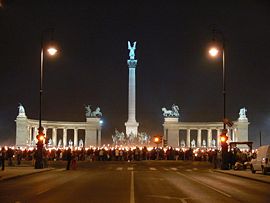
Following the war of 1848-49, the whole country was in "passive resistance". Archduke Albrecht von Habsburg was appointed governor of the Kingdom of Hungary, and this time was remembered for Germanization pursued with the help of Czech officers.
Due to external and internal problems, reforms seemed inevitable to secure the integrity of the Habsburg Empire. Major military defeats, like the Battle of Königgrätz (1866), forced the Emperor to concede internal reforms. To appease Hungarian separatism, the Emperor made a deal with Hungary, negotiated by Ferenc Deák, called the Austro-Hungarian Compromise of 1867, by which the dual Monarchy of Austria-Hungary came into existence. The two countries were governed separately with a common ruler and common foreign and military policies. The first prime minister of Hungary after the Compromise was Count Gyula Andrássy. The Hungarian Constitution was restored, and Franz Joseph was crowned as King of Hungary. The era witnessed an impressive economic development. The formerly backward Hungarian economy become a relatively modern and industrialized by the turn of the century, although agriculture remained fairly dominant. Many of the state institutions and the administrative system of Hungary were established during this period. However, Magyars represented a minority of the population: according to the 1787 data, the population of the Kingdom of Hungary numbered 2,322,000 Hungarians (29%) and 5,681,000 non-Hungarians (71%). In 1809, the population numbered 3,000,000 Hungarians (30%) and 7,000,000 non-Hungarians (70%). As an increasingly intense Magyarization policy was implemented after 1867, the census in 1910 (excluding Croatia), recorded the following distribution of population Hungarian 54.5%, Romanian 16.1%, Slovak 10.7%, and German 10.4%.The largest religious denomination was the Roman Catholic (49.3%), followed by the Calvinist (14.3%), Greek Orthodox (12.8%), Greek Catholic (11.0%), Lutheran (7.1%), and Jewish (5.0%) religions. In 1910, 6.37% of the population were eligible to vote in elections due to census.
In First World War Austria-Hungary was fighting on the side of Germany, Bulgaria and Turkey. With great difficulty, the Central Powers, as they were called, conquered Serbia and Romania but could not make significant progress against Italy. By 1918, the economic situation had deteriorated, uprisings in the army had become commonplace, and Entente troops had landed in Greece. In October 1918, the personal union with Austria was dissolved.
Between the two world wars (1918-1941)
In 1918, as a result of defeat in World War I, the Austro-Hungarian Monarchy collapsed. On October 31, 1918, the success of the Aster Revolution in Budapest brought the liberal count Mihály Károlyi to power as Prime-Minister. By February 1919 the government had lost all popular support, having failed on domestic and military fronts. On March 21, after the Entente military representative demanded more territorial concessions from Hungary, Károlyi resigned. The Communist Party of Hungary, led by Béla Kun, came to power and proclaimed the Hungarian Soviet Republic. The Communists – "The Reds" – came to power largely thanks to being the only group with an organized fighting force, and they promised that Hungary would defend its territory (possibly with the help of the Soviet Red Army). The Communists also promised equality and social justice. Initially, Kun's regime achieved some impressive military successes: the Hungarian Red Army, under the lead of the genius strategist, Colonel Aurél Stromfeld, ousted Czech troops from the north and planned to march against the Romanian army in the east. In terms of domestic policy, the Communist government nationalized industrial and commercial enterprises, socialized housing, transport, banking, medicine, cultural institutions, and all landholdings of more than 400,000 square metres. Still, the popular support of the Communists proved to be short lived. In the aftermath of a coup attempt, the government took a series of actions called the Red Terror, murdering several hundred people, which alienated much of the population. The Soviet Red Army was never able to aid the new Hungarian republic. Although it did not lose any battles, the Hungarian Red Army gave up land under pressure from the Entente. In the face of domestic backlash and an advancing Romanian force, Béla Kun and most of his comrades fled to Austria, while Budapest was occupied on August 6. All these events, and in particular the final military defeat, led to a deep feeling of dislike among the general population against the Soviet Union (which had not kept its promise to offer military assistance) and the Jews (since many members of Kun's government were Jewish, making it easy to blame the Jews for the government's mistakes). The new fighting force in Hungary were the Conservative counter-revolutionaries – the "Whites". These, who had been organizing in Vienna and established a counter-government in Szeged, assumed power, led by István Bethlen, a Transylvanian aristocrat, and Miklós Horthy, the former commander in chief of the Austro-Hungarian Navy. Starting in Western Hungary and spreading throughout the country, a White Terror began by other half-regular and half-militarist detachments (as the police power crashed, there were no serious national regular forces and authorities), and many Communists and other leftists were executed without trial. Radical Whites launched pogroms against the Jews, displayed as the cause of all the difficulties of Hungary. The leaving Romanian army pillaged the country: livestock, machinery and agricultural products were carried to Romania in hundreds of freight cars. The estimated property damage of their activity was so much that the international peace conference in 1919 did not require Hungary to pay war redemption to Romania. On November 16, with the consent of Romanian forces, Horthy's army marched into Budapest. His government gradually restored security, stopped terror, and set up authorities, but thousands of sympathizers of the Károlyi and Kun regimes were imprisoned. Radical political movements were suppressed. In March, the parliament restored the Hungarian monarchy but postponed electing a king until civil disorder had subsided. Instead, Miklos Horthy was elected Regent and was empowered, among other things, to appoint Hungary's Prime Minister, veto legislation, convene or dissolve the parliament, and command the armed forces.
Hungary's signing of the Treaty of Trianon on June 4, 1920, ratified the country's dismemberment. The territorial provisions of the treaty, which ensured continued discord between Hungary and its neighbors, required Hungary to surrender more than two-thirds of its pre-war lands, along ethnic lines (see picture above). However, nearly one-third of the 10 million ethnic Hungarians found themselves outside the diminished homeland. The country's ethnic composition was left almost homogeneous, Hungarians constituting about 90% of the population, Germans made up about 6%, and Slovaks, Croats, Romanians, Jews and Gypsies accounted for the remainder. New international borders separated Hungary's industrial base from its sources of raw materials and its former markets for agricultural and industrial products. Hungary lost 84% of its timber resources, 43% of its arable land, and 83% of its iron ore. Because most of the country's pre-war industry was concentrated near Budapest, Hungary retained about 51% of its industrial population, 56% of its industry, 82% of its heavy industry, and 70% of its banks. Horthy appointed Count Pál Teleki as Prime Minister in July 1920. His right-wing government issued a numerus clausus law, limiting admission of "political insecure elements" (these were often Jews) to universities and, in order to quiet rural discontent, took initial steps toward fulfilling a promise of major land reform by dividing about 3,850 km² from the largest estates into smallholdings. Teleki's government resigned, however, after, Charles IV, unsuccessfully attempted to retake Hungary's throne in March 1921. King Charles's return produced split parties between conservatives who favored a Habsburg restoration and nationalist right-wing radicals who supported election of a Hungarian king. Count István Bethlen, a non-affiliated right-wing member of the parliament, took advantage of this rift forming a new Party of Unity under his leadership. Horthy then appointed Bethlen prime minister. Charles IV died soon after he failed a second time to reclaim the throne in October 1921. (For more detail on Charles's attempts to retake the throne, see Charles IV of Hungary's conflict with Miklós Horthy.)
As prime minister, Bethlen dominated Hungarian politics between 1921 and 1931. He fashioned a political machine by amending the electoral law, providing jobs in the expanding bureaucracy to his supporters, and manipulating elections in rural areas. Bethlen restored order to the country by giving the radical counterrevolutionaries payoffs and government jobs in exchange for ceasing their campaign of terror against Jews and leftists. In 1921, he made a deal with the Social Democrats and trade unions (called Bethlen-Peyer Pact), agreeing, among other things, to legalize their activities and free political prisoners in return for their pledge to refrain from spreading anti-Hungarian propaganda, calling political strikes, and organizing the peasantry. Bethlen brought Hungary into the League of Nations in 1922 and out of international isolation by signing a treaty of friendship with Italy in 1927. The revision of the Treaty of Trianon rose to the top of Hungary's political agenda and the strategy employed by Bethlen consisted by strengthening the economy and building relations with stronger nations. Revision of the treaty had such a broad backing in Hungary that Bethlen used it, at least in part, to deflect criticism of his economic, social, and political policies. The Great Depression induced a drop in the standard of living and the political mood of the country shifted further toward the right. In 1932 Horthy appointed a new prime-minister, Gyula Gömbös, that changed the course of Hungarian policy towards closer cooperation with Germany and started an effort to magyarize the few remaining ethnic minorities in Hungary. Gömbös signed a trade agreement with Germany that drew Hungary's economy out of depression but made Hungary dependent on the German economy for both raw materials and markets. Adolf Hitler appealed to Hungarian desires for territorial revisionism, while extreme right wing organizations, like the Arrow Cross party, increasingly embraced Nazi policies, including those related to Jews. In an attempt to "take the wind out of the sails" of these groups and weaken their anti-Jewish appeals, the government passed the First Jewish Law in 1938. The law established a quote system to limit Jewish involvement in the Hungarian economy, while maintaining an unclear definition of the term "Jew." Imrédy’s attempts to improve Hungary’s diplomatic relations with the United Kingdom initially made him very unpopular with Germany and Italy. Undoubtedly aware of Germany's Anschluss with Austria in March, he realized that he could not afford to alienate Germany and Italy on a long term basis; in the autumn of 1938 his foreign policy became very much pro-German and pro-Italian. Intent on amassing a base of power in Hungarian right wing politics, Imrédy began to suppress political rivals, so the increasingly influential Arrow Cross Party was harassed, and eventually banned by Imrédy’s administration. As Imrédy drifted further to the right, he proposed that the government be reorganized along totalitarian lines and drafted a harsher Second Jewish Law. The Parliament under the new government of Pál Teleki approved the Second Jewish Law in 1939, which greatly restricted Jewish involvement in the economy, culture, and society and, significantly, defined Jews by race instead of religion. This definition altered the status of those who had formerly converted from Judaism to Christianity.
Hungary in World War II (1941-1945)
After being awarded by the Germans and Italians part of southern Czechoslovakia and Subcarpathia in the First Vienna Award of 1938, and then northern Transylvania in the Second Vienna Award of 1940, in 1941 Hungary participated in their first military maneuvers on the side of the Axis. Thus, Hungary was part of the invasion of Yugoslavia, gaining some more territory but effectively joining the Axis powers in the process (showing his non-agreement, prime minister Pál Teleki committed suicide). On 22 June 1941, Germany invaded the Soviet Union using the code name Operation Barbarossa. Hungary joined the German effort and declared war on the Soviet Union on 26 June, and entered World War II on the side of the Axis. In late 1941, the Hungarian troops on the Eastern Front experienced success at the Battle of Uman. By 1943, after the Hungarian Second Army suffered extremely heavy losses at the river Don, the Hungarian government sought to negotiate a surrender with the Allies. On 19 March 1944, as a result of this duplicity, German troops quietly occupied Hungary in what was known as Operation Margarethe. But, by now it was clear that the Hungarians were Germany's "unwilling satellite". On 15 October 1944, Horthy made a token effort to disengage Hungary from the war. This time the Germans launched Operation Panzerfaust and Horthy was replaced by a puppet government under the pro-German Prime Minister Ferenc Szálasi. Szálasi and his pro-Nazi Arrow Cross Party remained loyal to the Germans until the end of the war. In late 1944, Hungarian troops on the Eastern Front again experienced success at the Battle of Debrecen. But this was followed immediately by the Soviet invasion of Hungary and the Battle of Budapest. During the German occupation in May-June 1944, the Arrow Cross Party and Hungarian police deported nearly 440,000 Jews, mostly to Auschwitz. Over 400,000 Hungarian Jews were murdered during the Holocaust, as well as tens of thousands of Romani people. Hundreds of Hungarian people were also executed by the Arrow Cross Party for sheltering Jews. The war left Hungary devastated destroying over 60% of the economy and causing huge loss of life. On 13 February 1945, the Hungarian capital city surrendered unconditionally. On 8 May 1945, World War II in Europe officially ended.
Communist era (1947-1989)
Following the fall of Nazi Germany, Soviet troops occupied all of the country and through their influence Hungary gradually became a communist satellite state of the Soviet Union. After 1948, Communist leader Mátyás Rákosi established Stalinist rule in the country complete with forced collectivization and planned economy. The rule of the Rákosi government was nearly unbearable for Hungary's war-torn citizens. This led to the 1956 Hungarian Revolution and Hungary's temporary withdrawal from the Warsaw Pact. The Soviets retaliated massively with military force, sending in over 150,000 troops and 2,500 tanks. Nearly a quarter of a million people left the country during the brief time that the borders were open in 1956. From the 1960s through the late 1980s, Hungary was often satirically referred to as " the happiest barrack" within the Eastern bloc. This was under the autocratic rule of its controversial communist leader, János Kádár. The last Soviet soldier left the country in 1991 thus ending Soviet military presence in Hungary. With the Soviet Union gone the transition to a market economy began.
Hungarian Republic (1989-)
In June 1987 Károly Grósz took over as premier. In January 1988 all restrictions were lifted on foreign travel. In March demonstrations for democracy and civil rights brought 15,000 onto the streets. In May, after Kádár’s forced retirement, Grósz was named party secretary general. Under Grósz, Hungary began moving towards full democracy, change accelerated under the impetus of other party reformers such as Imre Pozsgay and Rezső Nyers. Also in June 1988, 30,000 demonstrated against Romania’s plans to demolish Transsylvanian villages.
In February, 1989 the Communist Party’s Central Committee, responding to ’public dissatisfaction’, announced it would permit a multi-party system in Hungary and hold free elections. In March, for the first time in decades, the government declared the anniversary of the 1848 Revolution a national holiday. Opposition demonstrations filled the streets of Budapest with more than 75,000 marchers. Grósz met Mikhail Gorbachev in Moscow, who condoned Hungary’s moves toward a multi-party system and promised that the USSR would not interfere in Hungary’s internal affairs. In May, Hungary began taking down its barbed wire fence along the Austrian border – the first tear in the Iron Curtain. June brought the reburial of Prime Minister Nagy, executed after the 1956 Revolution, drawing a crowd of 250,000 at the Heroes’ Square. The last speaker, 26-year-old Viktor Orbán publicly called for Soviet troops to leave Hungary. In July U.S. President George Bush visited Hungary. In September Foreign Minister Gyula Horn announced that East German refugees in Hungary would not be repatriated but would instead be allowed to go to the West. The resulting exodus shook East Germany and hastened the fall of the Berlin Wall. On October 23, Mátyás Szűrös declares Hungary a republic.
At a party congress in October 1989 the Communists agreed to give up their monopoly on power, paving the way for free elections in March 1990. The party’s name was changed from the Hungarian Socialist Workers’ Party to simply the Hungarian Socialist Party ( MSZP) and a new programme advocating social democracy and a free-market economy was adopted. This was not enough to shake off the stigma of four decades of autocratic rule, however, and the 1990 election was won by the centrist Hungarian Democratic Forum ( MDF), which advocated a gradual transition towards capitalism. The social-democratic Alliance of Free Democrats ( SZDSZ), which had called for much faster change, came second and the Socialist Party trailed far behind. As Gorbachev looked on, Hungary changed political systems with scarcely a murmur and the last Soviet troops left Hungary in June 1991.
In coalition with two smaller parties, the MDF provided Hungary with sound government during its hard transition to a full market economy. Antall died in December 1993 and was replaced by Interior Minister Péter Boross.
The economic changes of the past few years have resulted in declining living standards for most people in Hungary. In 1991 most state subsidies were removed, leading to a severe recession exacerbated by the fiscal austerity necessary to reduce inflation and stimulate investment. This made life difficult for many Hungarians, and in the May 1994 elections the Hungarian Socialist Party led by former Communists won an absolute majority in parliament. This in no way implied a return to the past, and party leader Gyula Horn was quick to point out that it was his party that had initiated the whole reform process in the first place (as foreign minister in 1989 Horn played a key role in opening Hungary's border with Austria). All three main political parties advocate economic liberalisation and closer ties with the West. In March 1996, Horn was re-elected as Socialist Party leader and confirmed that he would push ahead with the party’s economic stabilisation programme.
In 1997 in a national referendum 85% voted in favour of Hungary joining the NATO. A year later the European Union began negotiations with Hungary on full membership. In 1999 Hungary joined NATO. Hungary voted in favour of joining the EU, and joined in 2004.
Politics
The President of the Republic, elected by the Parliament every five years, has a largely ceremonial role, choosing the dates of elections.
The Prime Minister is elected by Parliament and can only be removed by a constructive vote of no confidence. The prime minister selects Cabinet ministers and has the exclusive right to dismiss them. Each Cabinet nominee appears before one or more parliamentary committees in open hearings and must be formally approved by the President.
A unicameral, 386-member National Assembly (the Országgyűlés) is the highest organ of state authority and initiates and approves legislation sponsored by the Prime Minister. National Parliamentary elections are held every four years; the next are due to be held in 2010.
An 11-member Constitutional Court has power to challenge legislation on grounds of unconstitutionality.
Regions, counties, and subregions
Administratively, Hungary is divided into 19 counties. In addition, the capital city (főváros), Budapest, is independent of any county government. The counties and the capital are the 20 NUTS third-level units of Hungary.
The counties are further subdivided into 173 subregions (kistérségek), and Budapest is its own subregion. Since 1996, the counties and City of Budapest have been grouped into 7 regions for statistical and development purposes. These seven regions constitute NUTS' second-level units of Hungary.
There are also 23 towns with county rights (singular megyei jogú város), sometimes known as "urban counties" in English (although there is no such term in Hungarian). The local authorities of these towns have extended powers, but these towns belong to the territory of the respective county instead of being independent territorial units.
| Places | Images |
|---|---|
Counties (County Capital)
Regions
|
Economy
Hungary held its first multi-party elections in 1990, following four decades of Communist rule, and has succeeded in transforming its centrally planned economy into a market economy. Both foreign ownership of and foreign investment in Hungarian firms are widespread. The governing coalition, comprising the Hungarian Socialist Party and the liberal Alliance of Free Democrats, prevailed in the April 2006 general election. Hungary needs to reduce government spending and further reform its economy in order to meet the 2012-13 target date for accession to the euro zone.
Hungary continues to demonstrate economic growth as one of the newest member countries of the European Union (since 2004). The private sector accounts for over 80% of GDP. Hungary gets nearly one third of all foreign direct investment flowing into Central Europe, with cumulative foreign direct investment totalling more than US$23 billion since 1989. It enjoys strong trade, fiscal, monetary, investment, business, and labor freedoms. The top income tax rate is fairly high, but corporate taxes are low. Inflation is low, it was on the rise in the past few years, but it is now starting to regulate. Investment in Hungary is easy, although it is subject to government licensing in security-sensitive areas. Foreign capital enjoys virtually the same protections and privileges as domestic capital. The rule of law is strong, a professional judiciary protects property rights, and the level of corruption is low. Total government spending is high, and many state-owned enterprises have not been privatized. Business licensing is also a problem, as regulations are not applied consistently.
According to the conservative think tank Heritage Foundation, Hungary's economy was 67.2 percent "free" in 2008, which makes it the world's 43rd-freest economy. Its overall score is 1 percent lower than last year, partially reflecting new methodological detail. Hungary is ranked 25th out of 41 countries in the European region, and its overall score is slightly lower than the regional average.
The Hungarian sovereign debt's credit rating is BBB+ as of July 2006, making Hungary the only other country in the EU apart from Poland not to enjoy an A grade score (2006). Foreign investors' trust in the Hungarian economy has declined, as they deem that the stringency measures planned in the second half of 2006 are not satisfactory, their focus being mainly on increasing the income side rather than curbing government spendings. Economic reform measures such as health care reform, tax reform, and local government financing are being addressed by the present government.
General government net lending was 9.2 percent in 2006, instead of estimated 10.1 percent (but still the largest in Europe) due to the austerity program of the government, and was 5.5 percent in 2007, and recent estimates of the government says 4 percent in 2008.
Because of the large austerity program, the real growth of the incomes was negative in 2007 at -5.5 percent, and the estimates say 1 percent increase in 2008. The GDP growth was only 1.4 percent in 2007, much lower than in 2006, due to the decreased government spending, in first quarter of 2008 the GDP growth was 1.7 percent, slightly stronger than last quarter of 2007 (0.9 percent), and some estimates say growth will pick up in range of 2.8-4.0 percent in the second half of 2008, due to starting of large investments, as 2400 megawatt Emfesz gas-fired power plant (the largest gas-fired power plant in Europe) next to the Ukrainian border (Nyírmeggyes), worth of 1.5 billion euros, a Mercedes-Benz car plant in Kecskemét, worth of 800 million euros (the largest investment in Hungary, since fall of communism), and Eurovegas casino-city next to the Slovakian and Austrian border (Bezenye), worth of 700 million euros. And much higher agricultural production in 2008, compared to the 2007 drought, will also help quick pick up in GDP growth.
Geography
Landscape
Slightly more than one half of Hungary's landscape consists of flat to rolling plains of the Carpathian Basin: the most important plain regions include the Little Hungarian Plain in the west, and the Great Hungarian Plain in the southeast. The highest elevation above sea level on the latter is only 183 metres.
Transdanubia is a primarily hilly region with a terrain varied by low mountains. These include the very eastern stretch of the Alps, Alpokalja, in the west of the country, the Transdanubian Medium Mountains, in the central region of Transdanubia, and the Mecsek Mountains and Villány Mountains in the south. The highest point of the area is the Írott-kő in the Alps, at 882 metres.
The highest mountains of the country are located in the Carpathians: these lie in the northern parts, in a wide band along the Slovakian border (highest point: the Kékes at 1,014 m (3327 ft)).
Hungary is divided in two by its main waterway, the Danube (Duna); other large rivers include the Tisza and Dráva, while Transdanubia contains Lake Balaton, a major body of water. The largest thermal lake in the world, Lake Hévíz ( Hévíz Spa), is located in Hungary. The second largest lake in the Carpathian Basin is the artificial Lake Tisza (Tisza-tó).
Phytogeographically, Hungary belongs to the Central European province of the Circumboreal Region within the Boreal Kingdom. According to the WWF, the territory of Hungary belongs to the ecoregion of Pannonian mixed forests.
Climate
Hungary has a Continental climate , with hot summers with low overall humidity levels but frequent rainshowers and frigid to cold snowy winters. Average annual temperature is 9.7 ° C (49.5 ° F). Temperature extremes are about 42 °C (110 °F) in the summer and −29 °C (−20 °F) in the winter. Average temperature in the summer is 27 to 35 °C (81 to 95 °F), and in the winter it is 0 to −15 °C (32 to 5 °F). The average yearly rainfall is approximately 600 millimeters (24 in). A small, southern region of the country near Pécs enjoys a reputation for a Mediterranean climate, but in reality it is only slightly warmer than the rest of the country and still receives snow during the winter.
Military
The Military of Hungary, or "Hungarian Armed Forces" currently has two branches, the " Hungarian Ground Force" and the " Hungarian Air Force." The Hungarian Ground Force (or Army) is known as the "Corps of Homeland Defenders" (Honvédség). This term was originally used to refer to the revolutionary army established by Lajos Kossuth and the National Defence Committee of the Revolutionary Hungarian Diet in September 1848 during the Hungarian Revolution.The term Honvédség is the name of the military of Hungary since 1848 referring to its purpose (véd in Honvéd) of defending the country. The Hungarian Army is called Magyar Honvédség. The rank equal to a Private is a Honvéd. The Hungarian Air Force is the air force branch of the Hungarian Army.
Demographics
Hungary's population by ethnicity
| Ethnic composition of Hungary (census 2001) |
||||
|---|---|---|---|---|
| Hungarian | 94.4% | |||
| Roma | 2.02% | |||
| German | 1.18% | |||
| Slovak | 0.38% | |||
| Other | 2.02% | |||
For 95% of the population, the mother language is Hungarian, a Finno-Ugric language unrelated to any neighbouring language and distantly related to Finnish and Estonian. The main Minority group are the Roma (2.1%). Other groups include: Germans (1.2%), Slovaks (0.4%), Croats (0.2%), Romanians (0.1%), Ukrainians (0.1%), and Serbs (0.1%).
- The Roma minority
The real number of Roma people, referred to as "Gypsies" or "Gipsies" in the English-speaking world, in Hungary is a disputed question. In the 2001 census, only 190,000 people declared themselves Roma, but experts and Roma organisations estimate that there are between 450,000 and 1,000,000 Roma living in Hungary. Since World War II, the size of the Roma population has increased rapidly. Today every fifth or sixth newborn Hungarian child belongs to the Roma minority. Estimates based on demographic trends claim that in 2050 around 20% (19.62% or 20.9%) of the population (1.2 million people) will be Roma.
Counties with the highest concentration of Roma minority are Borsod-Abaúj-Zemplén and Szabolcs-Szatmár-Bereg (officially 45,525 and 25,612 people in 2001), but there are other regions with a traditionally high Roma population like parts of Baranya and the middle reaches of the Tisza valley. Although they were traditionally living in the countryside, under general urbanization trends from the second half of the 20th century many of them moved into the cities. There is a sizeable Roma minority living in Budapest (12,273 people in 2001, officially).
Romas (called cigányok or romák in Hungarian) suffer particular problems in Hungary. Rampant poverty and a subsequent lack of education are the main origin of the bad position of the Romas. Racial prejudice compounds the issue. The traditional lifestyle of the Romas is often an obstacle to integration into society and it is a source of conflicts, especially in the villages. As a result, school segregation is especially acute, with many Roma children sent to classes for pupils with learning disabilities. Slightly more than 80% of Roma children complete primary education, but only one third continue studies into the intermediate (secondary) level. This is far lower than the more than 90% proportion of children of non-Roma families who continue studies at an intermediate level. The situation is made still worse by the fact that a large proportion of young Roma are qualified in subjects that provide them only limited chances for employment. Less than 1% of Roma hold higher educational certificates. Their low status on the job market and higher unemployment rates cause poverty, widespread social problems and crime.
Ethnic Hungarians in neighbouring countries
For historical reasons (see Treaty of Trianon), significant Hungarian minority populations can be found in the surrounding countries, notably in Romania (in Transylvania), Slovakia, Serbia (in Vojvodina), Ukraine (in Transcarpathia), Croatia (mainly Slavonia) and Austria (in Burgenland); Slovenia is also host to a number of ethnic Hungarians, where Hungarian language has an official status. See also:
- Hungarian minority in Romania
- Hungarians in Vojvodina
- Hungarians in Slovakia
Religion in Hungary
| Denominations | Population | % of total |
|---|---|---|
| Christianity | 7,584,115 | 74.4 |
| Catholicism | 5,558,901 | 54.5 |
| Roman Catholics | 5,289,521 | 51.9 |
| Greek Catholics | 268,935 | 2.6 |
| Protestantism | 1,985,576 | 19.5 |
| Calvinists | 1,622,796 | 15.9 |
| Lutherans | 304,705 | 3.0 |
| Baptists | 17,705 | 0.2 |
| Unitarians | 6,541 | 0.1 |
| Other Protestants | 33,829 | 0.3 |
| Orthodoxism | 15,298 | 0.1 |
| Other Christians | 24,340 | 0.2 |
| Judaism | 12,871 | 0.1 |
| Other religions | 13,567 | 0.1 |
| Total religions | 7,610,553 | 74.6 |
| No religion | 1,483,369 | 14.5 |
| Did not wish to answer | 1,034,767 | 10.1 |
| Unknown | 69,566 | 0.7 |
| total | 10,198,315 | 100.00 |
Religious history
The majority of Hungarian people became Christian in the 10th century. Hungary's first king, Saint Stephen I, took up Western Christianity, although his mother, Sarolt, was baptized in the eastern rite. Hungary remained predominantly Catholic until the 16th century, when the Reformation took place and, as a result, first Lutheranism, then soon afterwards Calvinism became the religion of almost the entire population. In the second half of the 16th century, however, Jesuits led a successful campaign of counterreformation among the Hungarians. The Jesuits founded educational institutions, including Péter Pázmány, the oldest university that still exists in Hungary, but organized so-called missions too in order to promote popular piety. By the 17th century, Hungary had once again become predominantly Catholic. The eastern parts of the country, however, especially around Debrecen ("the Calvinist Vatican") and Transylvania (except the majority of the Székelys), remained predominantly Protestant. Orthodox Christianity in Hungary has been the religion mainly of some national minorities in the country, notably, Romanians, Rusyns and Ukrainians, Serbs.
Hungary has been the home of a sizable Armenian community as well. They still worship according to the Armenian rite, but they have reunited with the Church of Rome ( Armenian Catholics) under the primacy of the Pope. According to the same pattern, a significant number of Orthodox Christians became re-united with the rest of the Catholic world ( Greek Catholics).
Jewish Hungarians
Hungary has been the home of a significant number of Jews, especially since the 19th century when many Jews, persecuted in Russia, found refuge in the Kingdom of Hungary. The largest synagogue in Europe is located in Budapest. Some Hungarian Jews were able to escape the Holocaust during World War II, although many were either deported to concentration camps or simply executed.
Today
The 2001 Hungarian Census showed religious adherency to be the following: Catholics 54.5%, Calvinist 15.9%, No Religion 14.5%, refused to answer 10.1%, Lutheran 3% and other 2%.
According to the most recent Eurobarometer Poll 2005,
- 44% of Hungarian citizens responded that "they believe there is a God".
- 31% answered that "they believe there is some sort of spirit or life force".
- 19% answered that "they do not believe there is any sort of spirit, God, or life force".
Culture
Architecture
Hungary is home to the largest synagogue in Europe ( Great Synagogue), the largest medicinal bath in Europe ( Széchenyi Medicinal Bath), the third largest church in Europe ( Esztergom Basilica), the second largest territorial abbey in the world ( Pannonhalma Archabbey), the second largest Baroque castle in the world ( Gödöllő), and the largest Early Christian Necropolis outside Italy ( Pécs).
Music
The music of Hungary consists mainly of traditional Hungarian folk music and music by prominent composers such as Liszt, Dohnányi, Bartók, Kodály, and Rózsa. Hungarian traditional music tends to have a strong dactylic rhythm, as the language is invariably stressed on the first syllable of each word. Hungary also has a number of internationally renowned composers of contemporary classical music, György Ligeti, György Kurtág, Péter Eötvös and Zoltán Jeney among them.
Literature
In the earliest times Hungarian language was written in a runic-like script (although it was not used for literature purposes in the modern interpretation). The country switched to the Latin alphabet after being Christianized under the reign of Stephen I (1000–1038). There are no existing documents from the pre-11th century era. The oldest written record in Hungarian is a fragment in the founding document of the Abbey of Tihany (1055) which contains several Hungarian terms, among them the words feheruuaru rea meneh hodu utu rea, "up the military road to Fehérvár" The rest of the document was written in Latin. The oldest complete text is the Funeral Sermon and Prayer (Halotti beszéd és könyörgés) (1192–1195), a translation of a Latin sermon. The oldest poem is the Old Hungarian Laments of Mary (Ómagyar Mária-siralom), also a (not very strict) translation from Latin, from the 13th century. It is also the oldest surviving Finno-Ugric poem. Among the first chronicles about Hungarian history were Gesta Hungarorum ("Deeds of the Hungarians") by the unknown author usually called Anonymus, and Gesta Hunnorum et Hungarorum ("Deeds of the Huns and the Hungarians") by Simon Kézai. Both are in Latin. These chronicles mix history with legends, so historically they are not always authentic. Another chronicle is the Képes krónika (Illustrated Chronicle), which was written for Louis the Great.
Renaissance literature flourished under the reign of King Matthias (1458–1490). Janus Pannonius, although wrote in Latin, counts as one of the most important persons in Hungarian literature, being the only significant Hungarian Humanist poet of the period. The first printing house was also founded during Matthias' reign, by András Hess, in Buda. The first book printed in Hungary was the Chronica Hungarorum. The most important poets of the period was Bálint Balassi (1554–1594) and Miklós Zrínyi (1620–1664). Balassi's poetry shows Mediaeval influences, his poems can be divided into three sections: love poems, war poems and religious poems. Zrínyi's most significant work, the epic Szigeti veszedelem (" Peril of Sziget", written in 1648/49) is written in a fashion similar to the Iliad, and recounts the heroic Battle of Szigetvár, where his great-grandfather died while defending the castle of Szigetvár. Among the religious literary works the most important is the Bible translation by Gáspár Károli, the Protestant pastor of Gönc, in 1590. The translation is called the Bible of Vizsoly, after the town where it was first published. (See Hungarian Bible translations for more details.)
The Hungarian enlightenment delayed about fifty years compared to the Western European enlightenment. The new thoughts arrived to Hungary across Vienna. The first enlightened writers were Maria Theresia's bodyguards ( György Bessenyei, János Batsányi and so on). The greatest poets of the time was Mihály Csokonai Vitéz and Dániel Berzsenyi. The greatest figure of the language reform was Ferenc Kazinczy. The Hungarian language became feasible for scientific explanations this time, farther a lot of new words were coined for describing new inventions.
Hungarian literature has recently gained some renown outside the borders of Hungary (mostly through translations into German, French and English). Some modern Hungarian authors became increasingly popular in Germany and Italy especially Sándor Márai, Péter Esterházy, Péter Nádas and Imre Kertész. The latter is a contemporary Jewish writer who survived the Holocaust and won the Nobel Prize for literature in 2002. The older classics of Hungarian literature and Hungarian poetry remained almost totally unknown outside Hungary. János Arany, a famous nineteenth century Hungarian poet is still much loved in Hungary (especially his collection of Ballads), among several other "true classics" like Sándor Petőfi, the poet of the Revolution of 1848, Endre Ady, Mihály Babits, Dezső Kosztolányi, Attila József and János Pilinszky. Other well-known Hungarian authors are Ferenc Mora, Geza Gardonyi, Zsigmond Móricz, Gyula Illyés, Albert Wass, and Magda Szabó.
Comics
Cuisine
Hungarian cuisine is also a prominent feature of Hungarian culture, with traditional dishes such as the world famous goulash (gulyás or gulyásleves) a main feature of the Hungarian diet. Dishes are often flavoured with paprika (pure powdered pepper), a Magyar innovation . Goulash is, contrary to popular belief, not a stew but an artistically prepared thick soup. Sour cream is often used to soften flavour. Fisherman’s soup ( halászlé) is a rich mixture of several kinds of poached fish, tomatoes, green peppers and paprika. It is a meal in itself. Lake Balaton pike-perch (fogas) is generally served breaded and fried or grilled. Other distinctive dishes include, chicken paprika, homemade pörkölt (stew), "vadas" which is a cooked wild meat in carrot sauce and special dumplings, and trout with almond. Goose liver (libamáj) is also very popular, either fried or grilled, cold or hot. Desserts include the iconic Dobos Cake, strudels (rétes in Hungarian, they are layered pastries filled with apple, cherry, poppyseed, curd or cheese), Gundel pancakes ( palacsinta), plum in pasta dumplings (szilvás gombóc), somlói dumplings and gesztenyepüré (cooked chestnuts mashed, topped with whipped cream). Specialities include salty and sweet pastas, of which túrós csusza (pasta with curd and sour cream) is the most famous.
Healthy brown bread is made from four to six different grains and is sprinkled with sesame seeds, sunflower seeds and rolled oats. Kifli is a wildly popular crescent roll made from reform dough.
The csárda is the most distinctive type of Hungarian inns, an old-style tavern offering traditional cuisine, wine and pálinka. Borozó usually denotes a cozy old-fashioned wine bar, pince is a beer or wine cellar and a söröző is a pub offering draught beer (csapolt sör) and sometimes meals. The bisztró is an inexpensive restaurant that is often self-service (önkiszolgáló). The büfé is the cheapest place, although one may have to eat standing at a counter. Pastries, cakes and coffee are served at a cukrászda, while an eszpresszó is a cafeteria.
- Drinks
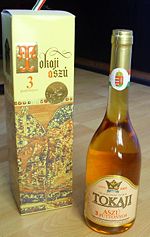
Pálinka: This alcoholic drink is distilled from fruit grown in the orchards situated on the Great Hungarian Plain. It is a spirit native to Hungary and comes in a variety of flavours including apricot ( barack) and cherry ( cseresznye). However plum ( szilva) is considered the best of all.
Beer: Beer goes well with many traditional Hungarian dishes and many Hungarians chose to drink is with their lunch. The four main Hungarian breweries are: Soproni, Arany Ászok, Kõbányai, and Dreher.
Wine: As Hugh Johnson says in its book, The History of Wine: the territory of Hungary is ideal for wine-making. Since the fall of communism we have seen the renaissance of Hungarian wine-making. The choice of good wine is widening from year to year. The country can be divided to six wine regions: North-Transdanubia, Lake Balaton, South-Pannónia, Duna-region or Alföld, Upper-Hungary and Tokaj-Hegyalja. The Hungarian wine regions offer a great variety of style: the main products of the country are elegant and full-bodied dry whites with good acidity, although complex sweet whites (Tokaj), elegant ( Eger) and full-bodied robust reds ( Villány and Szekszárd). The main varieties are: Olaszrizling, Hárslevelű, Furmint, Pinot gris or Szürkebarát, Chardonnay (whites), Kékfrankos (or Blaufrankisch in German), Kadarka, Portugieser, Zweigelt, Cabernet sauvignon, Cabernet franc and Merlot. The most famous wines from Hungary are Tokaji Aszú and Egri Bikavér.
Tokaji: Tokaji, meaning "of Tokaj", or "from Tokaj" in Hungarian, is used to label wines from the wine region of Tokaj-Hegyalja in Hungary.Tokaji wine has received accolades from numerous great writers and composers including Beethoven, Liszt, Schubert and Goethe; Joseph Haydn's favorite wine was a Tokaji. Louis XV and Frederick the Great tried to outdo one another in the excellence of the vintages they stocked when they treated guests like Voltaire to some Tokaji. Napoleon III, the last Emperor of the French, ordered 30–40 barrels of Tokaji for the Court every year. Gustav III, King of Sweden, never had any other wine to drink.In Russia, customers included Peter the Great and Empress Elizabeth of Russia.
Zwack Unicum: For over 150 years, a blend of 40 Hungarian herbs has been used to create Unicum. This is a bitter, dark-coloured liqueur that can be drunk as an apéritif or after a meal, thus helping digestion. The recipe is held in secrecy by the Zwack family.
Science
Hungary is famous for its excellent mathematics education which has trained numerous outstanding scientists. Famous Hungarian mathematicians include Paul Erdős (Erdős Pál), famed for publishing in over forty languages and whose Erdős numbers are still tracked; János (John) Bolyai (Bolyai János), designer of non-Euclidean (or "absolute") geometry in 1831; and John von Neumann (Neumann János), a pioneer of digital computing. Many Hungarian Jewish scientists, including Erdős, von Neumann, Edward Teller (Teller Ede), and Eugene Wigner (Wigner Jenő), fled rising anti-Semitism in Europe and made their most famous contributions in the United States.
Hungarian inventions include the noiseless match ( János Irinyi), Rubik's cube ( Ernő Rubik), and the krypton electric bulb ( Imre Bródy). Several other inventions were made by Hungarians who fled the country prior to World War II, including holography ( Dennis Gabor), the ballpoint pen ( László Bíró), the theory of the hydrogen bomb (Edward Teller (Teller Ede)), and the BASIC programming language ( John Kemeny, with Thomas E. Kurtz).
Sport
One of the most famous Hungarians is the footballer Ferenc Puskás (1927 – 2006). He scored 84 goals in 85 internationals for Hungary, and 511 goals in 533 matches in the Hungarian and Spanish leagues. Puskás played the 1954 World Cup final against West Germany. In 1958, after the Hungarian Revolution, he emigrated to Spain where he played in the legendary Real Madrid team that also included Alfredo Di Stéfano, and Francisco Gento.
Hungarians are also known for their prowess at water sports, mainly swimming, water polo (in which they have defeated the Soviet team in 1956) and canoeing (they have won multiple medals); this can be said to be surprising at first, due to Hungary being landlocked. On the other hand, the presence of two major rivers (the Duna and the Tisza) and a major lake ( Balaton) give excellent opportunities to practice these sports. Some of the world's best sabre fencing athletes have historically hailed from Hungary. The Hungarian national ice hockey team have also qualified for their first IIHF World Championship in more than seventy years.
Spa Culture
Hungary is a land of thermal water. A passion for spa culture and Hungarian history have been connected from the very beginning. It has been shown that Hungarian spa culture is multicultural. The basis of this claim is architecture: Hungarian spas feature Roman, Greek, Turkish, and northern country architectural elements. Due to an advantageous geographical location thermal water can be found with good quality and in great quantities on over 80% of Hungary’s territory. The Romans heralded the first age of spa in Hungary, the remains of their bath complexes are still to be seen in Óbuda, to this day. The spa culture was revived during the Turkish Invasion who used the thermal springs of Buda for the construction of a number of bathhouses, some of which are still functioning ( Király Baths, Rudas Baths). In the 19th century the advancement in deep drilling and medical science provided the springboard for a further leap in bathing culture. Grand spas such as Gellért Baths, Lukács Baths, Margaret Island, and Széchenyi Medicinal Bath are a reflection of this resurgence in popularity. Approximately 1,500 thermal springs can be found in Hungary. About half of these are used for bathing. The spa culture has a nearly 2,000 year history in Budapest. Budapest has the richest supply of thermal water among the capitals of the world. The amount of thermal water used in Budapest is roughly equal to two million bath tubs per day. There are approximately 450 public baths in Hungary. Nowadays the trend shows that bath operators are modernizing their facilities and expanding the services offered. A total of 50 of the 160 public baths are qualified as spas throughout the country. Services are offered for healing purposes. These spas provide every type of balneal and physical therapy. Throughout history bathing and spa tourism has always played an important role in Hungary.
- The thermal lake of Hévíz
The thermal lake of Hévíz is the largest biologically active, natural thermal lake of the world. The oldest and most well-known bath of Hungary, in accordance with records from the Roman era, has a history of 2000 years. The Hévíz treatment, in its present sense, also dates back more than 200 years. The 4.4 ha lake is fed by its spring rushing up at a depth of 38 m, containing sulphur, radium and minerals. Due to the high water output of the spring, the water of the lake is completely changed within 48 hours. The water of the Hévíz Lake is equally rich in dissolved substances and gases, combining the favourable effects of naturally carbonated medicinal waters and those containing sulphur, calcium, magnesium, hydrogen-carbonate, as well as those with a slightly radioactive content. The medicinal mud, which covers the bed of the lake in a thick layer, deserves special attention. The Hévíz mud, which is unique of its kind, contains both organic and inorganic substances and the radium-salts and reduced sulphuric solutions in it represent special medicinal factors. The medicinal water and mud originating from the several then thousand year-old Pannonian Sea, together with the complex physiotherapeutic treatments, are suitable for treating all kinds of rheumatic and locomotory diseases. The temperature of the water is 23-25 C in winter and 33-36 C in summer.
Folk Art
Folk Dance
Ugrós (Jumping dances): Old style dances dating back to the Middle Ages. Solo or couple dances accompanied by old style music, shepherd and other solo man’s dances from Transylvania, and marching dances along with remnants of medieval weapon dances belong in this group.
Karikázó: a circle dance performed by women only accompanied by singing of folksongs.
Csárdás: New style dances developed in the 18-19. centuries is the Hungarian name for the national dances, with Hungarian embroidered costumes and energetic music. From the men's intricate bootslapping dances to the ancient women's circle dances, Csárdás demonstrates the infectious exuberance of the Hungarian folk dancing still celebrated in the villages.
Verbunkos: a solo man’s dance evolved from the recruiting performances of the Austro-Hungarian army.
The Legényes: is a men's solo dance done by the ethnic Hungarian people living in the Kalotaszeg region of Transylvania. Although usually danced by young men, it can be also danced by older men. The dance is performed freestyle usually by one dancer at a time in front of the band. Women participate in the dance by standing in lines to the side and sing/shout verses while the men dance. Each lad does a number of points (dance phrases) typically 4 to 8 without repetition. Each point consists of 4 parts, each lasting 4 counts. The first part is usually the same for everyone (there are only a few variations).
Embroidery
It was in the beginning of the eighteenth century that the present style of Hungarian folk art took shape, incorporating both Renaissance and Baroque elements, depending on the area, as well as Persian Sassanide influences. Flowers and leaves, sometimes a bird or a spiral ornament, are the principal decorative themes. The most frequent ornament is a flower with a centerpiece resembling the eye of a peacock's feather. Nearly all the manifestations of folk art practiced elsewhere in Europe also flourished among the Magyar peasantry at one time or another, their ceramics and textile being the most highly developed of all. The finest achievements in their textile arts are the embroideries which vary from region to region. Those of Kalotaszeg in Transylvania are charming products of Oriental design, sewn chiefly in a single colour - red, blue, or black. Soft in line, the embroideries are applied on altar cloths, pillow cases and sheets. In Hungary proper Sárköz in Transdanubia and the Matyóföld in the Great Hungarian Plain produce the finest embroideries. In the Sárköz region the women's caps show black and white designs as delicate as lace and give evidence of the people's wonderfully subtle artistic feeling. The embroidery motifs applied to women's wear have also been transposed to tablecloths and runners suitable for modern use as wall decorations.
Black pottery
These vessels, made of black clay, reflect more than three hundred years of traditional Transdanubian folk patterns and shapes. No two are precisely alike, since all work is done by hand, including both the shaping and the decorating. The imprints are made by the thumb or a finger of the ceramist who makes the piece.
Hungarian public holidays and special events
Hungary has nine fixed public holidays:
| Date | English Name | Local Name | Remarks |
|---|---|---|---|
| January 1 | New Year's Day | Újév | |
| March 15 | National Day | Nemzeti ünnep | Márciusi ifjak ("March youths"), memorial day of the 1848 Revolution. There are usually speeches and music pieces performed; several people wear a cockade with the national colours (red, white and green). |
| Moveable | Easter Sunday | Húsvétvasárnap | Good Friday work-free for Protestants |
| Moveable | Easter Monday | Húsvéthétfő | Men visit women and ask for permission for sprinkling by reciting a little Easter poem, they sprinkle them with some perfume (or sometimes a bucket of cold water in the countryside), and they get eggs (mostly of chocolate) in exchange. Children get chocolate bunnies and eggs (from the Bunny), and sometimes fruits, nuts etc. as well. They sometimes have to look for these presents in the garden or in their room. (Living bunnies are not infrequent, either.) Mothers often cook turkey and/or ham for dinner. |
| May 1 | Labour day; anniversary of the accession to the EU |
A munka ünnepe | The countries of the EU are represented with special programmes, bridges are decorated and exhibitions are arranged. |
| Moveable | Pentecost Sunday | Pünkösdvasárnap | Sunday, 50 days after Easter |
| Moveable | Pentecost Monday | Pünkösdhétfő | Monday after Pentecost |
| August 20 | Saint Stephen Day | Szent István ünnepe | St. Stephen's Day, Foundation of State, "the day of the new bread" as well. St. Stephen of Hungary (Szent István király in Hungarian) (ca. 975 – August 15, 1038), was the first king of Hungary. Celebrated with a half-hour fireworks on the bank of the Danube in the evening, attended by several hundreds of thousands of people. |
| October 23 | National Day | Nemzeti ünnep | The day of the Republic (since 1989), 1956 Revolution memorial day. Celebrated with speeches and exhibitions. |
| November 1 | All Saints Day, Day of the Dead | Mindenszentek, Halottak napja | It is a day to remember the lost ones. On this day people generally visit all their lost relatives' graves which they decorate with flowers. |
| December 24 evening, December 25 |
Christmas | Karácsony | People buy (or make) presents for their relatives and friends in the preceding couple of weeks (so this period is the absolute boom of the year for most stores). Public transport stops operating at about 4 p.m. Families reunite and people prepare their (labelled) presents under the Christmas tree. It is made of a fir which is decorated by one or two people in the family so nobody else can see it before they signal with a little bell for the rest to come in. The family sings Christmas songs together and everyone unwraps their presents. On 25th, people usually visit their farther relatives (eg. aunts, uncles and grandparents) and exchange presents. |
| December 26 | Second Day of Christmas | Karácsony másnapja |
Holidays not endorsed by the state:
| Date | English Name | Local Name | Remarks |
|---|---|---|---|
| December 6 | Santa Claus, Saint Nicholas Day | Télapó, Mikulás | Children get various chocolate pieces from the Santa Claus by morning. If they were bad, they might get (birch) rods exclusively or beside their presents. |
| December 31 | New Year's Eve | Szilveszter | Young people go partying until morning. Streets are noisy with paper trumpets, hoots and champagne cracks; people often wear masks. Those who stay home usually watch the comedies made for this occasion; at midnight they drink champagne and wish each other good luck for the new year. National television channels broadcast the orchestral and choral national anthem at midnight, and then the speech of the current President. With these finished, further comedies and various movies follow. The next day streets are as empty as ever, and people sleep long (or sleep themselves sober). |
| Moveable | Carnival | Farsang | A six day regional carnival, originally celebrated by the Šokci (ethnic- Croatians) living in the town of Mohács. Traditions include folk music, masquerading, parades and dancing. |
Hungarian domestic animals
There are special Hungarian species of domestic animals which are seen as national symbols in Hungary, and there are "gene banks" to ensure their survival, especially in national parks.
- Long-horn Hungarian Grey Cattle- Hungarian breed, traditionally kept in the open full year. Nowadays they are raised for infant food due to natural, healthy meat.
- Magyar Vizsla - one of the oldest hunting dogs of the world. The ancestors of this dog came into the Carpathian Basin with the nomadic Hungarian tribes.
- Hungarian Puli - small shepherd dog
- Hungarian Komondor - large shepherd dog, was brought to Hungary a thousand years ago by nomadic Magyars.
- Hungarian Kuvasz - large shepherd dog.
- Hungarian Pumi - small shepherd dog.
- Magyar Agár (Hungarian Greyhound) is already known in the 8th century, it is as old as the Vizsla.
- Transylvanian Bloodhound - Hungarian hound.
- Hungarian Mudi shepherd dog.
- Hungarian thoroughbred horses - a mid-19th century mixture of the best Arab and English race horse characteristics.
- Mangalica, a breed of pigs, characterised by their long curly hair and relatively fatty meat which makes them ideal for making sausages and salami.
Special events
Hungary’s most outstanding annual events include the Budapest Spring Festival (mid-march to mid-April), Hortobágy Equestrian Days (late June), Sopron Early Music Days (late June), Búcsú (Farewell), Festival in Budapest (late June), Miskolc Opera Festival (late June), Miskolc Kalálka International Folk Festival (July), Győr Summer Festival (late June), Győr Summer Cultural Festival (late June to lateJuly), Pannon Festival in Pécs (July and August), Szentendre Summer Festival (July), Kőszeg Street Theatre Festival (late July), Savaria International Dance Competition in Szombathely (July), Debrecen Jazz Days (July), Szeged Open Air Festival (mid-July to August), Diáksziget (Student Island or Pepsi Island) north of Budapest (August), Eger Wine Harvest Festival (September), and Budapest Autumn Arts Festival (mid-September to mid-October).
St Stephen’s Day (20 August) is celebrated with sporting events, parades and fireworks nationwide. On the same day there is a Floral Festival in Debrecen and a Bridge Fair in nearby Hortobágy. Formula 1 car races are held in early August at the Hungaroring near Mogyoród, 24 km northeast of Budapest.
Budapest Spring Festival
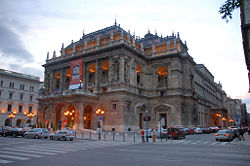
Designed to fit the needs of Budapest’s cultural heritage and its requirements as a modern Central European centre, this metropolitan festival was instituted in 1981. By presenting and disseminating cultural assets it boosts the city’s image and encourages dynamic development of its cultural tourism. This "festival of festivals", traditionally covering a range of artistic fields, presents a series of homogeneous artistic activities to which international professional symposia are linked. The Budapest Spring Festival takes place in the last two weeks of March. Its main emphasis is on those symphony orchestra concerts, opera and ballet performances which will appeal to the widest audience, but the program also includes open-air events and an Operetta Festival. The performances take place in the capital’s most important concert halls and theatres, and often near historic monuments. Over the years a number of regional towns have been included in the Budapest Spring Festival - Debrecen, Gödöllő, Győr, Kaposvár, Kecskemét, Sopron, Szentendre and Szombathely - and thus it has more or less expanded into a national festival. The list of events always includes renowned foreign guests as well as distinguished artists and groups from the Hungarian musical life. Highlights include classical concerts, productions at the Opera House, open air events, the Operetta Festival, the Dance House Convention, the Dance Panorama, and what are considered to be the real treat, the exhibitions.
Haydn Festival in Eszterháza
Haydn at Eszterháza: During its first quarter century, the palace was the primary home of the celebrated composer Joseph Haydn, who wrote the majority of his symphonies for the Prince's orchestra. Starting in 1768, the theatre was a major venue for opera, often with more than a hundred performances per year. The palace was geographically isolated, a factor which led to loneliness and tedium among the musicians. This is seen in some of Haydn's letters, as well as in the famous tale of the Farewell Symphony
The basic aim of the festival is to evoke the musical paradise that Eszterháza was in Haydn's time, within the original walls, with the help of period instruments and performing practice. The programmes focus mainly on the works composed during the Eszterháza period of Haydn's creative life, and among these, on compositions belonging to the most important genres (symphonies, string quartets, keyboard sonatas and trios). In addition, however, the concert programmes regularly include works by the "unknown Haydn" (baryton pieces, rarely-heard church compositions, wind divertimenti, etc.). The festival aims to provide opportunities for the world's most outstanding Haydn performers to meet here, to gain inspiration from the atmosphere and acoustics of the place, and to inspire one another through shared music-making. The majority of the performers play only compositions by Joseph Haydn, but also in exceptional cases other works closely connected, either directly or through their composers, with Haydn, Eszterháza or the family of the Esterházy princes - such as, for example, the string quartets dedicated to Haydn by Mozart, and certain pieces by Michael Haydn (the composer's younger brother), Luigi Tomasini (leader of the Eszterháza orchestra) and others. The venue for most of the concerts is the enchantingly beautiful ceremonial hall of the palace, which has superb acoustics. Some of the more intimate, solistic performances are given in the sala terrena, the central hall of the original, smaller, Renaissance hunting palace. Some concerts of church music take place in one or other of the churches in the nearby villages.
Győr Summer Festival
This festival is held annually, from the second week in June to the second week in July. The Győr Summer International Cultural Festival, which displays Győr's cultural heritage, has a history of over three decades. The list of events, which covers a wide range of genres, is based on a series of separate activities. Every year, for a month in June and July, the Baroque decorations of the city centre, its atmospheric courtyards and the banks of the Rába river are home to the International Ballet Festival, the International Puppet and Street Theatre Convention, the International Folk Dancing and Folk Music Festival, and the International Handcraft Fair and Exhibition. In addition to the performances of the hosts - the Győr Ballet, the Győr National Theatre, and the Győr Philharmonic Orchestra - visitors can also see those of the visiting theatre companies and musical groups .


